标签:图片 amp port mic 处理 struct tom int red
Filter过滤器
当访问服务器资源的时候,过滤器可以将i气你个球拦截下来,完成一些特殊的功能
过滤器的作用:
一般用于完成通用的操作,如验证登陆,统一的编码处理,敏感字符过滤。就是打游戏骂人,会出现****
快速入门
步骤:1定义一个类,实现接口Filter
2 复写方法
3 配置拦截资源,包括注解配置和,web.xml配置
1111
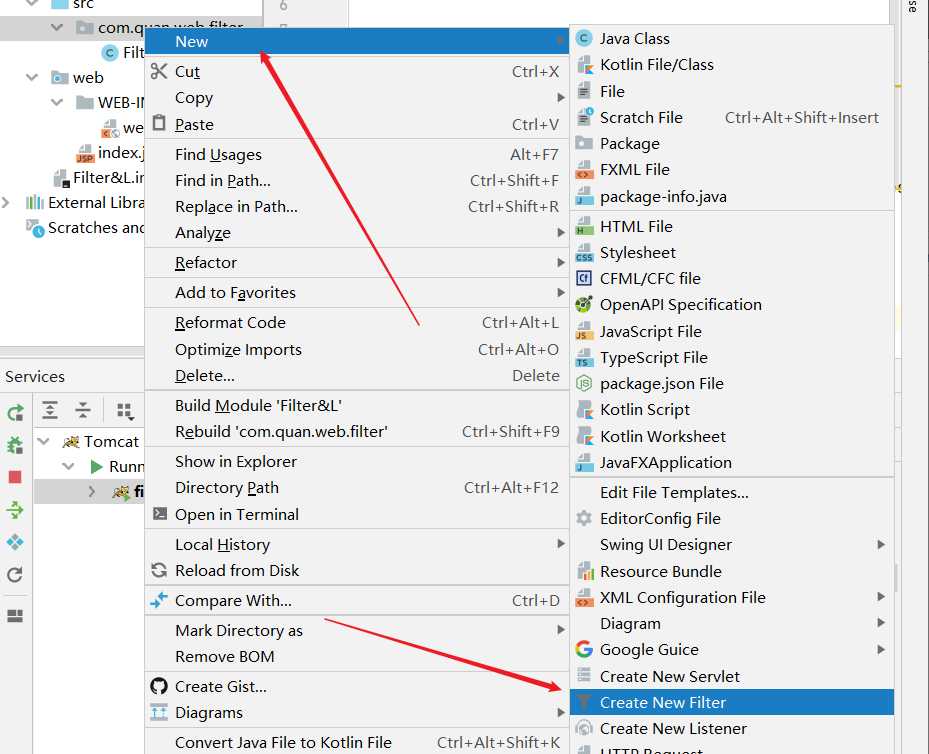
2222
package com.quan.web.filter; import javax.servlet.*; import javax.servlet.annotation.WebFilter; import java.io.IOException; @WebFilter("/*") public class FilterDemo implements Filter { public void destroy() { } @Override public void doFilter(ServletRequest req, ServletResponse resp, FilterChain chain) throws ServletException, IOException { System.out.println("FilterDemo被执行了。。。。"); } @Override public void init(javax.servlet.FilterConfig config) throws ServletException { } }
333注解:
@WebFilter("/*") 拦截所有请求:
测试
自行加入sevlet容器管理 Tomcat ;
运行
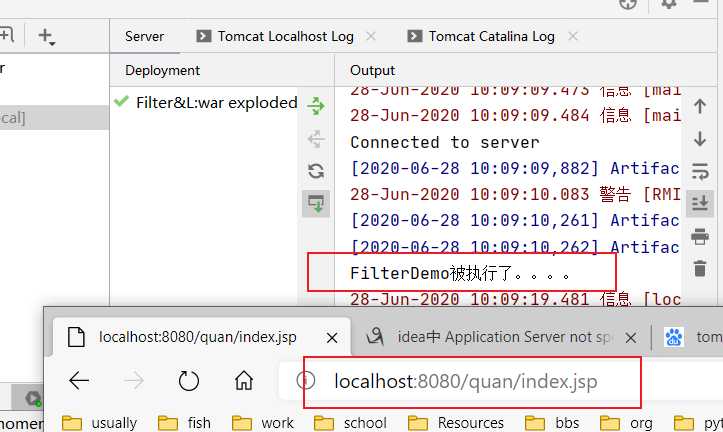
拦截器进行放行操作
再上面的doFilter方法中加入
chain.doFilter(req,resp);
测试

filter的web.xml配置
和sevlet的配置差不多,只是这个是拦截的路径
<filter>
<filter-name>FilterDemo</filter-name>
<filter-class>com.quan.web.filter.FilterDemo</filter-class>
</filter>
<filter-mapping>
<filter-name>FilterDemo</filter-name>
<url-pattern>/*</url-pattern>
</filter-mapping>
过滤器的执行流程
我们可以新建一个filter
@WebFilter("/*")
public class FilterDemo2 implements Filter {
public void destroy() {
}
public void doFilter(ServletRequest req, ServletResponse resp, FilterChain chain) throws ServletException, IOException {
//对request对象请求消息增强
System.out.println("filterDemo2 doing.....");
chain.doFilter(req, resp);
//对response对象的响应消息增强
System.out.println("filterDemo2 ending....");
}
public void init(FilterConfig config) throws ServletException {
}
}
修改一下index.jsp
<html>
<head>
<title>$Title$</title>
</head>
<body>
index.jsp.....
<%
System.out.println("index.jsp....");
%>
</body>
</html>
备注:两个百分号之间,用于输出到控制台
运行结果;
filterDemo2 doing.....
index.jsp....
filterDemo2 ending....
由上面的测试可以知道
filter执行的过程是,到达filter,
11进行一些请求增强操作,
22然后通过放行到后端的servlet 或者资源,
33再回到filer中放行之后的操作
filter的生命周期
11再服务器启动后,创建Filter对象,然后调用init方法,用于加载资源
22每一次请求拦截资源时候,会执行
33服务器关闭后,Filter对象被销毁,,释放资源
过程理解
@WebFilter("/*")
public class FilterDemo3 implements Filter {
/**
* 服务器关闭后,Filter对象被销毁,,释放资源
* 如果服务器是正常关闭,则会执行destroy方法
* 只执行一次
*/
public void destroy() {
System.out.println("destroy.....");
}
/**
* 每一次请求拦截资源时候,会执行
* @param req
* @param resp
* @param chain
* @throws ServletException
* @throws IOException
*/
public void doFilter(ServletRequest req, ServletResponse resp, FilterChain chain) throws ServletException, IOException {
System.out.println("doFilter....");
chain.doFilter(req, resp);
}
/**
* 再服务器启动后,创建Filter对象,然后调用init方法,用于加载资源
* 只执行一次
* @param config
* @throws ServletException
*/
public void init(FilterConfig config) throws ServletException {
System.out.println("init....");
}
}
查看日志
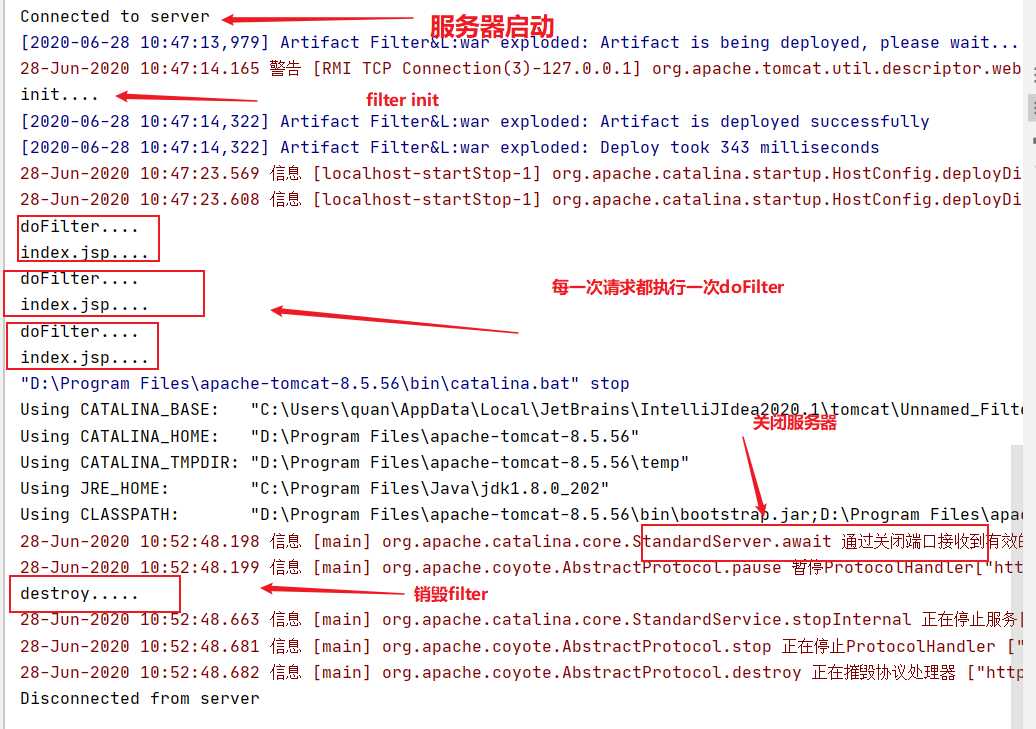
过滤器配置----拦截路径配置
1具体路径配置
/index.jsp 只有访问index.jsp资源时,过滤器才会被执行
2目录拦截配置
/user/* 访问/user下的所有资源时,过滤器都会被执行
3后缀名拦截:
*.jsp 访问所有后缀名为jsp资源时,过滤器都会被执
4拦截所有资源:
/* 访问所有资源时,过滤器都会被执行
//@WebFilter("/index.jsp") 只有访问index.jsp资源时,过滤器才会被执行 //@WebFilter("/user/*") 访问/user下的所有资源时,过滤器都会被执行 @WebFilter("*.jsp") //访问所有后缀名为jsp资源时,过滤器都会被执行 public class FilterDemo4 implements Filter { public void destroy() { } public void doFilter(ServletRequest req, ServletResponse resp, FilterChain chain) throws ServletException, IOException { System.out.println("filterDemo4"); chain.doFilter(req, resp); } public void init(FilterConfig config) throws ServletException { } }
过滤器配置----拦截方式配置
资源被访问的方式

注解配置:
dispatcherTypes = DispatcherType.REQUEST
@WebServlet("/user/updateServlet")
public class ServletDemo2 extends HttpServlet {
protected void doPost(HttpServletRequest request, HttpServletResponse response) throws ServletException, IOException {
System.out.println("updateServlet");
//转发到index.jsp
request.getRequestDispatcher("/index.jsp").forward(request,response);
}
protected void doGet(HttpServletRequest request, HttpServletResponse response) throws ServletException, IOException {
this.doPost(request,response);
}
}
//浏览器直接请求index.jsp资源时,该过滤器才会被执行 @WebFilter(value = "/index.jsp",dispatcherTypes = DispatcherType.REQUEST) public class FilterDemo5 implements Filter { public void destroy() { } public void doFilter(ServletRequest req, ServletResponse resp, FilterChain chain) throws ServletException, IOException { System.out.println("filterDemo5...."); chain.doFilter(req, resp); } public void init(FilterConfig config) throws ServletException { } }
直接访问时:
http://localhost:8080/quan/index.jsp
结果:

通过间接转发访问时:
http://localhost:8080/quan/user/updateServlet
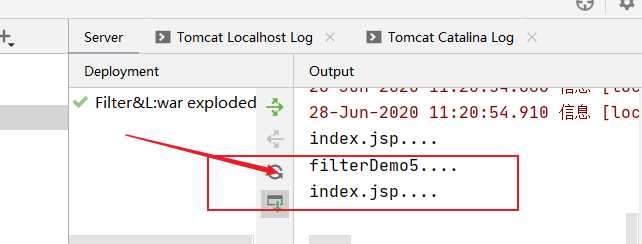
dispatcherTypes = DispatcherType.FORWARD
只有转发访问index.jsp时,该过滤器才会被执行
@WebFilter(value = "/index.jsp",dispatcherTypes = DispatcherType.FORWARD)
dispatcherTypes可以配置多个值
@WebFilter(value = "/index.jsp",dispatcherTypes = {DispatcherType.FORWARD,DispatcherType.REQUEST})
web.xml配置
<filter>
<filter-name>FilterDemo</filter-name>
<filter-class>com.quan.web.filter.FilterDemo</filter-class>
</filter>
<filter-mapping>
<filter-name>FilterDemo</filter-name>
<url-pattern>/*</url-pattern>
<dispatcher>FORWARD</dispatcher>
<dispatcher>REQUEST</dispatcher>
</filter-mapping>
<dispatcher> 标签也是有五个值得。
过滤器链(配置多个过滤器)
执行顺序

编写第一个过滤器:
package com.quan.web.filter; import javax.servlet.*; import javax.servlet.annotation.WebFilter; import java.io.IOException; @WebFilter("/*") public class FilterDemo6 implements Filter { public void destroy() { } public void doFilter(ServletRequest req, ServletResponse resp, FilterChain chain) throws ServletException, IOException { System.out.println("FilterDemo6执行!!!!!!!!!!!"); chain.doFilter(req, resp); System.out.println("FilterDemo6回来执行!!!!!!!!!!!"); } public void init(FilterConfig config) throws ServletException { } }
编写第二个过滤器:
package com.quan.web.filter; import javax.servlet.*; import javax.servlet.annotation.WebFilter; import java.io.IOException; @WebFilter("/*") public class FilterDemo7 implements Filter { public void destroy() { } public void doFilter(ServletRequest req, ServletResponse resp, FilterChain chain) throws ServletException, IOException { System.out.println("FilterDemo7执行!!!!!!!!!!!"); chain.doFilter(req, resp); System.out.println("FilterDemo7回来执行!!!!!!!!!!!"); } public void init(FilterConfig config) throws ServletException { } }
测试访问路径:
http://localhost:8080/quan/index.jsp
日志输出:
FilterDemo6执行!!!!!!!!!!!
FilterDemo7执行!!!!!!!!!!!
index.jsp....
FilterDemo7回来执行!!!!!!!!!!!
FilterDemo6回来执行!!!!!!!!!!!
过滤器先后顺序问题:

Filter的小案例------登陆验证
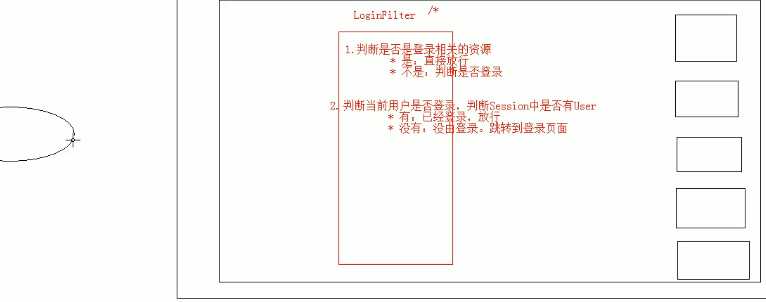
Listener

监听器的使用步骤

web.xml配置
<!-- 配置监听器-->
<listener>
<listener-class>com.quan.web.listener.ListenerDemo1</listener-class>
</listener>
<!-- 资源文件-->
<context-param>
<param-name>contextConfigLocation</param-name>
<param-value>application.xml</param-value>
</context-param>
监听器内容:
public class ListenerDemo1 implements ServletContextListener { // Public constructor is required by servlet spec public ListenerDemo1() { } // // ------------------------------------------------------- // 监听ServletContext对象创建的,ServletContext对象服务器启动后自动创建 // 服务器启动后自动调用 // ------------------------------------------------------- public void contextInitialized(ServletContextEvent sce) { System.out.println("ServletContextEvent done....."); //一般会进行资源的加载文件 //1获取ServletContext对象 ServletContext servletContext = sce.getServletContext(); //2加载资源文件 String contextConfigLocation = servletContext.getInitParameter("contextConfigLocation"); //3获取真实路径 InputStream fis = servletContext.getResourceAsStream(contextConfigLocation); System.out.println(fis); } /** * 再服务器关闭后,ServletContext对象被销毁, * 当服务器正常关闭后,该方法被调用 * @param sce */ public void contextDestroyed(ServletContextEvent sce) { System.out.println("ServletContextEvent out...."); } }

标签:图片 amp port mic 处理 struct tom int red
原文地址:https://www.cnblogs.com/java-quan/p/13202273.html